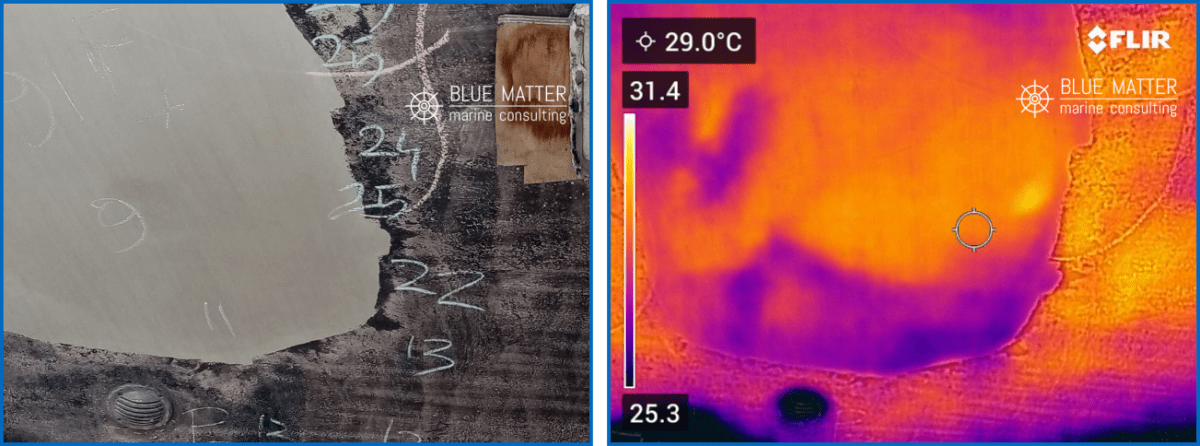
Thermal imaging in Marine Surveys...
Introducing the unseen world of thermal imaging in marine surveys! As yacht owners, we understand that keeping our vessels in prime condition is a top priority. But what if we could see beyond what meets the eye? Let’s unveil thermal imaging, a cutting-edge technology that brings a whole new dimension to marine surveys. In this blog post, we will dive into the fascinating realm of thermal imaging and explore how it enhances marine surveys by revealing hidden issues, improving safety, and optimizing vessel performance. Get ready to discover the power of seeing the unseen with thermal
imaging in marine surveys!
Benefits of Thermal Imaging for Marine Surveys:
What Can It Reveal?
Thermal imaging technology is based on the principle that all objects emit heat energy in the form of infrared radiation. Thermal cameras are designed to capture this radiation and convert it into a visible image that represents the temperature distribution of the object.
In marine surveys, thermography can be used to reveal a wide range of information that may not be visible to the naked eye. For example, it can detect areas of moisture intrusion, delamination, or corrosion in the vessel’s structure, electrical systems, or machinery. It can also identify hot-spots in electrical systems, engines, and other machinery that may indicate potential fire hazards. Furthermore, thermography can be used to inspect insulation, piping, and fuel systems for potential leaks or blockages. Understanding the benefits of thermal imaging in marine surveys can help yacht owners and marine surveyors better appreciate the value of this technology in enhancing vessel inspection and maintenance.o

Case Studies: Real-Life Examples of Thermal Imaging in Marine Surveys
Real-life examples can showcase the practical applications of thermal imaging in marine surveys. Case studies can highlight how thermal imaging has been used to detect moisture intrusion in vessel interiors, identify electrical faults, locate water leaks in fuel tanks, diagnose overheating issues in engines, detect delamination or corrosion in the vessel’s structure, identify fouling in the hull or propellers, or inspect insulation and piping for leaks or blockages. As you can clearly see at the pictures below, we have successfully detected trapped moisture in the encapsulated keel, improper fiberglass repair, and overheating electrical components which were not really visible to the naked eye during the survey.
Considerations for Incorporating Thermal Imaging into Marine Surveying Practices
Incorporating thermal imaging into marine surveying practices requires careful consideration of various factors. Factors such as the resolution and temperature range of the thermal camera, the portability of the equipment, and the cost of implementation should be taken into account. Furthermore, considerations for operator training and certification, compliance with industry standards and regulations, and integration with existing surveying processes should be considered. Providing guidance on these considerations can help readers make informed decisions and effectively implement this technology in their inspections and maintenance routines.

In conclusion, incorporating thermal imaging into marine surveying practices can greatly enhance the effectiveness and efficiency of vessel inspections and maintenance routines. However, it is crucial to highlight the importance of the training and experience of the marine surveyor when utilizing thermal imaging technology. The accuracy and reliability of thermal imaging results greatly depend on the expertise and proficiency of the operator.

Thermal imaging is a specialized technology that requires proper training and understanding of the
principles of infrared radiation, as well as the specific applications and limitations of thermal cameras in marine surveys. Marine surveyors should undergo comprehensive training and obtain relevant certifications to ensure their proficiency in operating thermal cameras, interpreting thermal images, and identifying potential issues accurately. They should also have a thorough understanding of the marine environment, vessel systems, and structural components and the characteristics of the boat building materials to effectively interpret thermal images and make informed assessments.
 Experience also plays a crucial role in the effective utilization of thermal imaging in marine surveys. An experienced marine surveyor with a track record of using thermal imaging technology can bring valuable insights and expertise to the inspection process. They can identify subtle abnormalities or patterns in thermal images that may indicate potential issues, and provide practical recommendations for maintenance or repairs.
Experience also plays a crucial role in the effective utilization of thermal imaging in marine surveys. An experienced marine surveyor with a track record of using thermal imaging technology can bring valuable insights and expertise to the inspection process. They can identify subtle abnormalities or patterns in thermal images that may indicate potential issues, and provide practical recommendations for maintenance or repairs.
In a nutshell, there is no magic tech-toy to reveal all of the secrets of a vessel. Correct answers always come with the combination of the knowledge, skills, training and the experience in marine surveying. So I cannot emphasize that every boat owner should be encouraged to work with qualified and experienced marine surveyors who are proficient in thermal imaging to ensure the reliability and effectiveness of their vessel inspections and maintenance routines.
Fair winds and happy sailing.
Blue Matter Marine Consulting
Principal Surveyor
Assoc. IIMS – A1762
Navtech USSA MMS21020A
